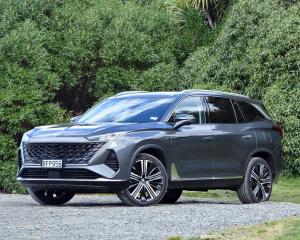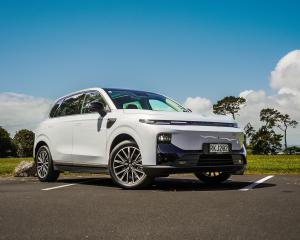
ROAD TEST
David Thomson takes the Toyota C-HR for a drive.
What’s new?
Startlingly bold in its styling when first introduced in 2017, Toyota’s C-HR compact crossover SUV has now moved firmly into its second generation, with the latest model on sale here for several months now.
This new C-HR sits on an updated versions of the same underlying TNGA platform as its predecessor. Aside from being a little wider, its dimensions are near-identical to those of the outgoing model, including the same 2640mm wheelbase.
There are changes under the bonnet though, with the move to just two engine options for New Zealand, both hybrids of the non-plug-in variety. Dropping pure-petrol options from the lineup makes sense as Toyota chases lower emissions targets in this country, but it’s less clear why the plug-in hybrid variant available in some overseas markets is not offered.
Opt for a front-drive variant of the new C-HR (of which all but one are) and you will be acquiring a vehicle propelled by a 1.8-litre petrol powerplant that — with hybrid assist included — delivers peak outputs of 103kW of power and 142Nm of torque. The sole AWD variant takes the same hybrid approach, but with a 2.0-litre petrol engine, enabling combined peak outputs of 145kW and 190Nm.
In each case power delivery is via a multi-stage continuously variable transmission.
Eliminating a pure petrol option from the lineup lifts the entry price point for the C-HR, which now opens at $45,990 for the GX. Next step up is the GXL at $49,990 and the Limited at $52,990. The sole all-wheel-drive is the GR Sport at $55,990.
Price comparisons are interesting not just with potential rivals from other brands, but also with the Toyota Corolla Cross, which has arrived on the scene since the original C-HR made its debut. Variant-for-variant, the Corolla Cross is slightly cheaper, which is initially counter-intuitive given that it is also a little bigger.
Presumably there is a price premium for the more daring look of the C-HR, and perhaps there’s also the question of real-world availability; an older colleague of mine looking to replace his conventional Corolla with something that rode a little higher considered both the Corolla Cross and the C-HR, and went for the latter in part because Toyota NZ could supply it more quickly.
What comes as standard?
One might be tempted to dismiss the entry-level GX as a fleet-focused bargain machine, but I was quite impressed by what was provisioned when an example arrived for appraisal. Standard features include smart entry and push button start, a fully digital main instrument cluster, a 12.3" centre touchscreen, smartphone mirroring, satellite navigation, a 6-speaker sound system, dual zone climate control, front and rear parking sensors and a panorama camera system. There’s a 12-volt socket and dual USB plug points as well as Bluetooth connectivity and voice control.
The standard safety suite is comprehensive too. It includes a pre-collision system with autonomous emergency braking, pedestrian, cyclist and motorcycle detection, intersection turn assist, and emergency steering assist. There’s also a driver monitoring camera, radar cruise control with curve speed reduction, lane keeping assist, road sign assist, blind spot monitoring, rear cross traffic alert, tyre pressure monitoring, and auto-dipping headlights.

Stepping up to the Limited (also tested by Drivesouth) adds 19" alloys, a heads-up display, digital rear-view mirror, leather accented trim, a panorama sunroof and a premium 9-speaker sound system.
Reading through the specifications I was initially surprised to see that the Limited also has a superior boot capacity of 443 litres, rather than 356-litres; that’s because it dispenses with a space saver spare wheel under the boot floor in favour of an emergency repair kit. A repair kit is also part of the GR Sport package, but boot space for this variant slips back to 422-litres due to the AWD drive system. Otherwise, it’s a very similar equipment specification to the Limited, but with a more overtly sporty exterior body, and sports trims and accents.
What’s it look like?
Thanks in part to Toyota having adopted a less conservative look for many of its models in recent years, the new C-HR doesn’t have quite the shock visual impact of its predecessor. That said, objectively it is more boldly styled, with super-sharp angular crease lines on its main exterior panels, and the nose extensively reworked to incorporate Toyota’s latest "hammerhead" design cues. Neat elements at the rear include the illuminated name that briefly shows between the tail-lights at start up.
The coupe-like styling adds to the dynamic appearance of a vehicle that looks assuredly planted on the road, especially on those higher-spec vehicles that take larger wheels and slightly wider tyres. Moving up the specification ladder also adds other cues that further spice up the C-HR’s appearance, most notably on the GR Sport.
For those after the ultimate in eye-catching looks, both the GR Sport and Limited are available with a special two-tone paint finish for an extra $1000 over their standard list price. This is quite a dramatic treatment, in which both the roof and rear panel section aft of the doors are finished in black.
The photos that accompany this test are intentionally of a base model GX, albeit in a colour called deep amethyst that has seemingly been discontinued from the C-HR palate, to give a sense of how sharp the vehicle looks even in its least garnished form.
What’s it like inside?
The same spirit of innovative design that marks the exterior of the C-HR is apparent within the cabin. Up front, the key controls and displays are gently angled to the driver, and the front of the cabin manages to feel both airy and comfortably snug at the same time.
Attention to detail is apparent in the choice of materials, and in the high standards of fit and finish. As one might expect, the Limited variant tested after the GX boasted plusher finishes, but GX’s cabin was still pleasantly appointed and attractively presented, with quality cloth trims and soft-touch surfacing across the top of the dash.
Separated by a centre console that includes integrated cupholders and a small, lidded centre bin, the front seats were comfortable on both variants, though perhaps just a shade light on upper-back support. There’s plenty of adjustability for the driver in particular, which should enable folk of varying heights and sizes to get comfortable behind the wheel.
The rear of the cabin is tighter for room, with the plunging roofline impacting on headroom, and the high-waisted window line and wrap-around rear pillar giving a closed-in feel only partly mitigated by the presence of the panorama roof on the Limited.
Of course, for those who do want a little extra rear room, Toyota now offers the Corolla Cross, or the option of stepping up to a substantially larger RAV4. C-HR boot space is adequate by compact SUV standards, and can be close to tripled by folding the 60:40 split rear seats down.
Alongside a very long list of things Toyota have emphatically got right with the detailing of the new C-HR, there are two small things I think they have got wrong.

The second is the central locking mechanism for the doors, which activates with a startlingly loud "clunk"; this, presumably, could be easily addressed with better damping for the latches and locking mechanism.
What’s it like to drive?
Describing the C-HR as an easy and undemanding car to drive is meant as a compliment, as these are attributes that are important to many buyers of vehicles of this type.
It’s a handy vehicle to place accurately on the road, steering in a precise and quite direct fashion, and being smooth and responsive under gentle acceleration and during braking. The suite of cameras and parking sensors largely overcome its major round-town limitation of poor visibility to the rear.
The 1.8-litre powertrain, which featured on both variants assessed by Drivesouth, is at its best at gentle-to-moderate throttle openings, with the extra thrust of the hybrid system’s electric motor ensuring reasonably brisk and fuss-free initial acceleration from rest, or when gathering speed from low in the rear range. Performance is dulled and mechanical refinement takes a hit under hard acceleration, with the engine tending to become thrashy at higher revs. Road rumble can also become intrusive traversing coarse-chip seal at highway speeds.
Ride quality, on the other hand, is excellent at all speeds, and handling is always predictable and confidence-inspiring, even when pushing down winding backroads at speeds unlikely to be approached by your typical owner. Body control is also very good given the C-HR is a higher-riding crossover machine.
Assured handling and pleasing levels of dynamic prowess should come as no surprise, mind; the C-HR’s underlying TNGA-C platform is very good, and there have been a number of important suspension enhancements for this second-generation machine.
Economy is pretty good too: while the claimed 4.4 litre/100km standard cycle figure wasn’t achieved on testing in local conditions, a few days behind the wheel of the GX netted a 5.5 litre/100km return, while the Limited returned 6.0 litre/100km in less economy-friendly conditions.
These returns were achieved driving both cars predominantly in "normal" drive mode, with some time in sport mode, and virtually no time in eco mode, which dulled the car’s mechanical response too much for my liking. There’s also an "EV" mode for very short hops under battery alone, and a "B" mode that maximises non-mechanical braking for steep downhill descents.
Verdict
The original 2017 C-HR was something utterly fresh and new for Toyota, with a visual fun factor that was unique in the Japanese company’s model range at the time. Objectively even bolder, but subjectively less startling, the second-generation successor is a fine compact crossover too, combining tried-and-true mechanical with eye-catching styling, and an appealing, quality feel within the cabin.
AT A GLANCE
TOYOTA C-HR GR & LIMITED
Overall rating: ★★★★+

Interior: ★★★★+
Performance: ★★★+
Ride and handling: ★★★★
Safety: ★★★★★
Environmental: ★★★+
SPECIFICATIONS
Price: $45,990 (GCX) / $52,990 (Limited)
Engine: Hybrid 1.8-litre petrol four-cylinder and lithium-ion battery-powered electric motor, maximum combined power 103kW, maximum torque 142Nm.
Transmission: CVT automatic, front-wheel-drive.
Safety rating: 5-star Ancap.
Wheels & Tyres: 17-inch alloy wheels with 215/65 R17 tyres (GX) / 19-inch alloy wheels with 225/50 R19 tyres (Limited).
Fuel and economy: 91 octane petrol, 4.4l/100km, tank capacity 43 litres.
Emissions: 98g CO2/100km on combined cycle.
Dimensions: Length, 4360mm; width, 1832mm; height, 1564mm.












